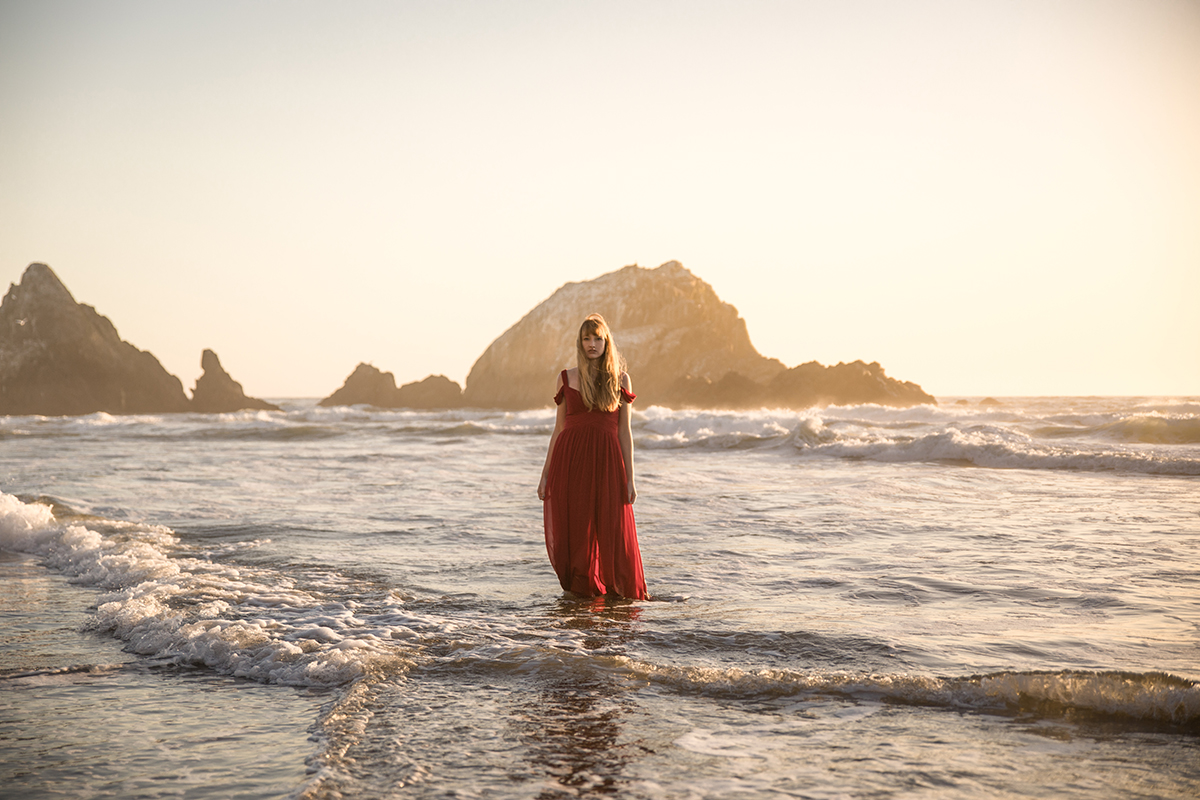Requiem for a Dreamscape
Ted Chin heads to the San Francisco shoreline with his Tamron SP 24-70mm VC and SP 85mm VC lenses for a surreal-portrait session.
More Photo Tips | Video Gallery | Photo Gallery | Enewsletter sign-up
By Jenn Gidman
Images by Ted Chin
Ted Chin always knew he wanted to be an artist—he just struggled for a while on which kind to be. "I'd done photography, painting, drawing, and screenprinting, among other genres," he says. When he moved to San Francisco three years ago to go to grad school for animation, he took that opportunity to enhance his Photoshop skills and combined them with his photographic knowledge, leading him to the artistic niche he's now comfortably nestled in.
"Combining these two skill sets allowed me to evolve my own, surreal style," he says. "This was important, because when I moved to San Francisco, I became more involved in the Instagram community and started seeing the work of many different photographers and artists. I knew I had to figure out what I could do to stand out more. My mission became to create images that almost looked like movie scenes, but at the same time as real as possible. My goal is to turn impossible concepts into realistic images."
Thus was born "Ted's Little Dream," the unofficial name for his compilation of dreamlike images that has brought him more than 71,000 followers on Instagram. "These photos also let me wander off to places I can't get to myself," he says. "Grad school is really hands-on, so while other people traveled in real life, I traveled through my images. It's all about exploring the world and offering my perspective on how I see things."
His distinct, scaled style often involves a tiny subject set within a larger landscape. "Seeing how small we are in this world makes us appreciate our existence," he says. "I enjoy taking portraits, but I want everyone to view my subjects in the context of that larger world. It's like if you're in a valley in Yosemite, feeling so small, or like if you're watching a movie and seeing things through the character's eyes as she walks through a door and suddenly witnesses a sweeping landscape in front of her."
Ted recently had the chance to head to San Francisco's Ocean Beach for a shoot, during an unseasonably warm weekend for that time of year (early June). "It was around 7pm, with that perfect lighting you get during golden hour," Ted says. "In fact, the lighting was so soft that I didn't want to use any reflectors or flash."
He used as his main lenses for this session the Tamron SP 24-70mm F/2.8 VC and the SP 85mm F/1.8 VC prime. "I love these two lenses," he says. "The 24-70 allows me to control the distance between myself and my subject, and offers me the versatility I need so I can change my perspective without having to relocate. The 85mm, meanwhile, is a wonderful portrait lens that offers a more personal connection between subject and viewer."
To direct his subject during this session, Ted chatted with her as he set up his camera and his beachfront stage. "I gave her a sense of the moves I wanted her to make and what direction I was going for," he says. "Then, for each individual image as we were shooting, I'd tell her to go for a certain sensibility or vibe, using her own perspective, maybe doing something a little more or a little less with her movements, or moving her body so that it somehow matched up with her facial expression. It was a back-and-forth process."
Ted prefers to take his time with each photo and be meticulous about every aspect of the image—and using the 24-70 offers him the flexibility to not only capture the scenery and environment surrounding his model, but also to zoom in and out on her without having to move and sacrifice the other aspects of the image he worked so hard to set up. "I want the light to be the same in my images, and the background to be similar," he says. "But when you move around to get different perspectives, you can lose one or both of those things—and then something about the image just doesn't look right. When you can zoom in and out, you keep what you want and easily change your perspective."
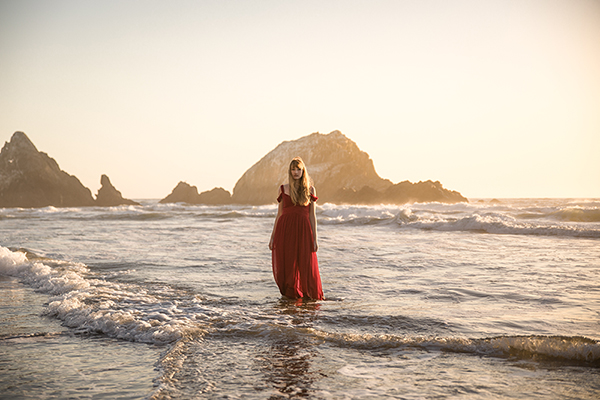
52mm, F/2.8, 1/1000th sec., ISO 100
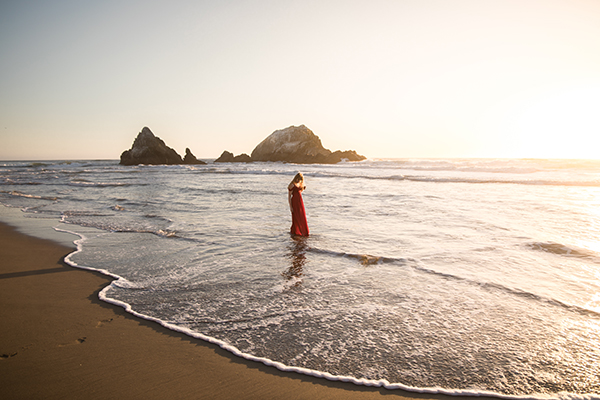
24mm, F/2.8, 1/500th sec., ISO 100
For the next two photos of this shoot, Ted wanted to zoom in for more intimate close-ups, so he switched over to the 85mm prime. "This lens is perfect for taking a portrait," he says. "I love to have my f-stop wide open at the maximum aperture of F/1.8 in photos like this, because I want the viewer to focus on my subjects more than the background or surrounding area." Using the 85mm allows him to still show the complementary scenery, but the focus remains on the person—her hand gestures, her facial expressions, and, by extension, her feelings.
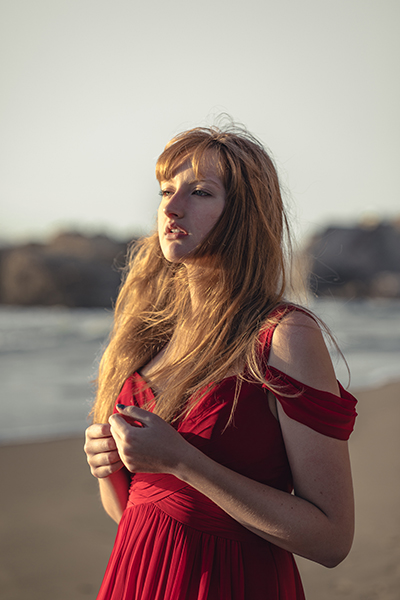
85mm, F/2.8, 1/1600th sec., ISO 100
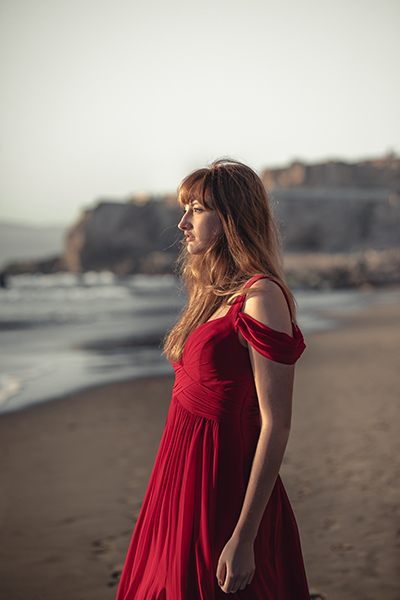
85mm, F/2.8, 1/2000th sec., ISO 100
[Image of Pirate Ship]
Making composites is one of Ted's favorite parts of the image-creating workflow. "Sometimes I'll come up with an idea before the shoot—maybe I'll have a stock photo that I'll build off of—and sometimes it organically happens during the shoot," he says. "For this image, my model was standing in the water with that rock behind her, and I thought it would be really cool to have another subject in back of her. That's when I thought of the pirate ship. I wanted to create a story, or at least spur viewers to think of different stories on their own. Like a Pirates of the Caribbean scenario, or maybe her ship crashed and she's stranded, or maybe she's looking for treasure. It's all up to the viewers: I offer the starting point, and they take it from there."
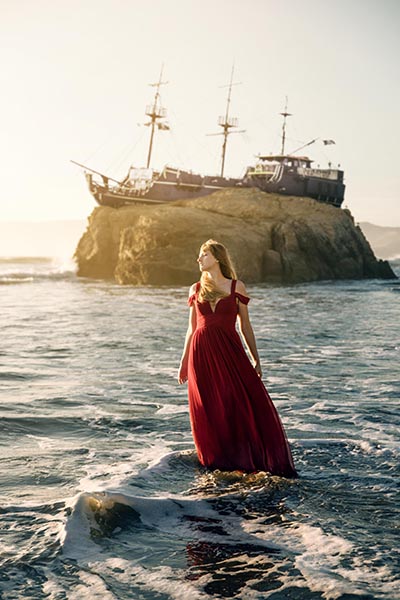
52mm, F/2.8, 1/1000th sec., ISO 100
When it comes to post-production, whether he's creating a straightforward portrait or a more surreal depiction, Ted draws upon his retouching experience working for a high-end fashion company. "I like to keep it as real as possible while enhancing the details," he explains. "I'll mainly bring out the highlights and the shadows. For the Pirate Ship photo, I smoothed her skin a little, but not too much, so you can still see some lines and the texture of her skin. The same with her hair: It looks like someone's real, actual hair, not too perfect and not too distracting at the same time. I also made sure to strengthen the color contrast. With the red dress, the blue ocean, and the orange tint in the sky, I wanted to make sure it all blended naturally."
To see more of Ted Chin's work, go to www.tedslittledream.com.
More Photo Tips | Watch Videos | Learn More About Tamron Lenses | Photo Gallery
